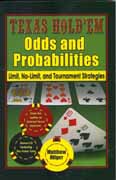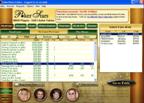
Texas Hold'em Odds and Probabilities
Miscalculating Odds with Two Cards to Come
 Matthew Hilger is a professional poker player and respected author. In addition to the many articles on his own website, he writes columns for CardPlayer magazine, PokerPages.com and PokerinEurope.com. Matthew's next book, Texas Hold'em Odds and Probabilities: Limit, No-Limit and Tournament Strategies, will be released in June 2006. Matthew's website is www.internettexasholdem.com their poker hand odds with two cards to come. This article is going to show why this often can lead to mistakes.
Matthew Hilger is a professional poker player and respected author. In addition to the many articles on his own website, he writes columns for CardPlayer magazine, PokerPages.com and PokerinEurope.com. Matthew's next book, Texas Hold'em Odds and Probabilities: Limit, No-Limit and Tournament Strategies, will be released in June 2006. Matthew's website is www.internettexasholdem.com their poker hand odds with two cards to come. This article is going to show why this often can lead to mistakes.
On the flop, you can calculate the poker hand odds of improving on the next card or you can calculate the poker hand odds of improving on either the turn or the river. Many poker players use “Out” charts which have the poker odd calculations done for you so that you can easily see the poker hand odds given a certain number of outs. Calculating the poker hand odds probabilities of improving is rather straightforward. The mistakes come when poker players start to make decisions based on the poker hand odds with two cards to come.
For example, let’s say you have a gut shot draw. The poker hand odds of improving on the next card are 11 to 1. The poker hand odds of improving on either the turn or river are 5 to 1. Players who always call on the flop when they are getting 5 to 1 pot odds are making a mistake. Let’s take a closer look at this.
• Many poker players forget to include the cost of the turn bet. If you are going to draw to the river with two cards to come, you must include the cost of the turn bet in your calculation. For example, you have a gut shot draw in a $1-$2 game and there is $5 in the pot. You are getting 5 to 1 pot odds. Your poker hand odds of improving by the river are 5 to 1. If you only consider the $1 bet on the flop then you would call; however, this is incorrect since you will have to pay $1 on the flop and $2 on the river. The 5 to 1 poker hand odds of improving is based on receiving two cards so you must include the cost of receiving two cards in your calculation; therefore, you need to be able to win $15 for calling to be correct ($3 x 5). With only $5 in the pot on the flop, it will difficult to win an additional $10 from your poker opponents to justify a call.
• It is often correct to call on the flop and fold on the turn. Even when you include the cost of the turn bet in your calculation, this will still lead to mistakes as sometimes you will fold even though calling one more bet on the flop is correct.
Let’s say that in the above example there is $8 in the pot and you are faced with a $1 bet. If you are using poker hand odds with two cards to come, you would again calculate that you need to win $15 in this pot to justify calling. It is doubtful you would win an additional $7 on the turn and river from your poker opponents so you decide to fold. However, this would be a mistake. On the flop, you only have to pay $1 to see one more card. The poker hand odds of improving on the next card are 11 to 1. Therefore, you need to win a total of $11 to justify calling on the flop. With $8 in the pot, you are getting pretty good implied poker hand odds that you will win an additional $3 on the turn and/or river to justify a single call on the flop. In this particular example, it is often correct to call on the flop when the bets are small and then fold on the turn when the bets get bigger. Sometimes you eliminate this possibility when using poker hand odds with two cards to come.
• When using poker hand odds with two cards to come you sometimes commit yourself to seeing the river no matter what happens. This can be a mistake as the pot can be raised, the turn will change the context of the board which may counterfeit your outs, etc.
So how should you make decisions when applying poker hand odds and probabilities of improving? In limit poker, you should make them one street at a time. On the flop, calculate the poker hand odds of improving on the next card and then compare them to the implied pot odds you are receiving. The implied pot odds includes the total amount currently in the pot plus any additional bets you expect to win from your poker opponents should you improve (sometimes you might improve on the turn only to lose on the river so you need to include this possibility in your calculations). If you don’t improve on the turn, go through the same process of comparing the poker hand odds of improving on the river to the implied pot odds. When you make decisions one step at a time you’ll avoid mistakes and avoid over-committing to a pot when the situation might change.
Some of you might be asking, “When do you use poker hand odds with two cards to come and why do a lot of poker books show an “Out” chart for two cards to come?” Poker hand odds with two cards to come should be used in allin situations. This occurs a lot in no-limit poker. Someone bets and you are going to be allin on the flop. In this case, two card poker hand odds are very helpful. This can happen also in Limit poker when either you or your poker opponent might be in an allin situation because of a small stack, but this is not too common. In my book, Internet Texas Hold’em, I decided to take out the two-card column in the “Out” chart of the revised edition to eliminate confusion about this topic since you rarely use two-card outs in limit poker.
Next article: Online Poker Mistake #4 - Calling Raises Too Often on the Turn

